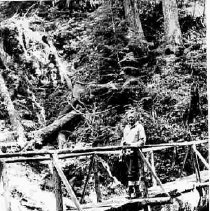Photo Record
Images

Metadata
PN# |
PN07534 |
Date |
1934-1936 |
Description |
A B W museum print of a man dressed in work clothes standing on a wooden walkway across a gully. He is holding something in each hand which appears to be pipe fittings of some sort, strung on cord or wire. In the foreground and background are logs and bushes. This photograph has a dark contrast to it and has unevenly cut borders and edges. The man in this photo is identified in PN07560 as the timekeeper for the Vancouver Island Gold Mines. |
History |
PN07531-PN07568 are museum copies of 38 black and white photographs of mining activities at the Vancouver Island Gold Mine on Mineral Hill in the China Creek area. An Alberni District Newspaper Article of January 25, 1934, states "The Vancouver Island Gold Mines Ltd., has taken over four old Crown granted claims at the head of China Creek, ten miles from Alberni, and is carrying on operations steadily. This property was formerly the Alberni Consolidated and was owned and operated by James Dunsmuir forty years ago. The old workings consist of fifty-foot shaft and a tunnel 200 feet long, both on the main vein." President of the Vancouver Island Gold Mines was Mr. H.S. Hoffar, president of the Boeing Aircraft of Canada Ltd. [Alberni Newspaper Article, February 8, 1934]. Access to the mine was gained by a logging railway for part of the way, then by a road first built by Dunsmuir's coal miners from Nanaimo. The Vancouver Island Gold Mines used a Caterpillar tractor on this road for hauling supplies. The camp was "one of the most modern in British Columbia...It is built as a single unit along the mountainside, which slopes at an angle of 43 degrees, and is completely equipped with electric light, running water, and telephone. An assay office with the latest type of equipment is attached to the living quarters." [Alberni District Newspaper, August 9, 1934.]. A complete report on the mine diggings and their results is available from the 'Report from the Minister of Mines', 1935-36. According to 'Pick, Pan and Pack', p.56, the mine was most active between 1934-36, employing an average of 10-12 men. The tunnel cost $15,000 to make in 1934. Muckers received $3 a day, miners $4 a day. Lars Sundstrom (donor) says he was one of the first hired and one of the last to leave. In this photo, according to Mr. Sundstrom (donor), "The tree had fallen across the gully so they just built a walkway on top of it. Added rails or something to hang on to". This may be the same bridge as in PN07533. |
